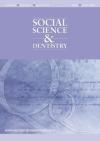Social Science and Dentistry

- Cover Date:
- June 2012
- Print ISSN:
- 2040-4263
- Vol:
- 2
- Issue:
- 1
Acquisition and measurement of dental anxiety: a summary paper
Why is it important to research dental anxiety and phobia? Despite advances in local anaesthetic and treatment techniques, fear of dentistry is still a widespread problem. Findings from the latest UK Adult Dental Health Survey showed that 36% of the respondents have moderate dental anxiety, with 12% indicating severe clinically significant anxiety (Health and Social Care Information Centre, 2010). Moreover, this finding has been mirrored across other countries, with moderate to high levels of dental anxiety noted in Australia (Armfield et al., 2006), Canada (Locker et al., 1999) and Norway (Skaret et al., 1998). Anxiety surrounding the dentist and dental procedures can have negative consequences for physical, social and psychological well-being. Those who are dentally anxious tend to have poor attendance rates at dental appointments (MejÃa et al., 2010), often resulting in poor oral health (Oosterink et al., 2009). As oral health deteriorates this can have a profound effect on sufferers’ social relationships, and they often experience sleep disturbance, negative physiological impact and decreased vitality (Cohen et al., 2000; Mehrstedt et al., 2002; Oosterink et al., 2009). Dental anxiety has major implications not only for the individual but also for the dental professional and dental care services. Indeed, providing treatment for a dentally anxious patient can be time consuming and demanding for clinicians and can have financial implications for dental services (Moore and Brodsgaard, 2001; Weinstein, 2008). Given the adverse effects of dental anxiety/phobia, it is important to understand why it develops and be able to formally identify and quantify this anxiety. Therefore, the aims of this summary paper are two-fold. First, to outline and review some of the key explanations put forward for how dental anxiety/ phobia develops. Second, to cover the assessment options for measuring adult and child dental anxiety. It should be noted that this is not a systematic review of the literature, rather a brief summary paper covering only some of the main issues. Psychodynamic explanations There are a number of theories that attempt to explain why individuals acquire dental anxiety. For example, Freeman (1998) has proposed a psychodynamic theory for dental phobia based on the concepts of false connections and displacement. Using case illustrations she has demonstrated how false connections
Key words: Dental anxiety, Cognitive Vulnerability Model, measures of anxiety
- Article Price
- £15.00
- Institution Article Price
- £
- Page Start
- 20
- Page End
- 24
- Authors
- Heather Buchanan
Articles from this issue
- Title
- Pg. Start
- Pg. End
- Perceptions of Australian Mothers on Infant Teething: A Pilot Investigation Using a Mixed Methods Approach
- 3
- 11
- AFTER and beyond: cancer recurrence fears and a test of an intervention in oral and oropharyngeal patients
- 29
- 38
